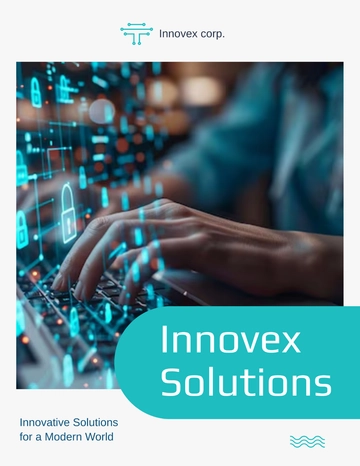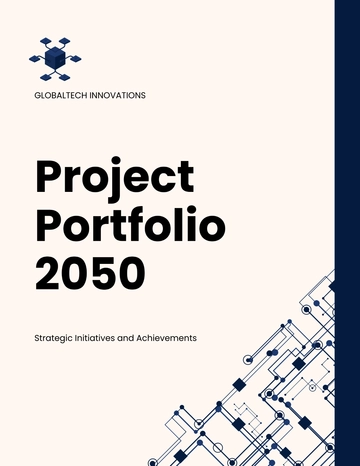Free Finance Mergers & Acquisitions Portfolio

I. Introduction
A. Background
Operating within the dynamic and ever-evolving finance industry, our organization recognizes the paramount importance of strategic agility and innovation. This portfolio is born out of this understanding, serving as a proactive response to industry shifts and a strategic framework to effectively navigate the intricacies of Mergers and Acquisitions (M&A). This framework positions our organization within the finance sector to harness M&A opportunities, ensuring adaptability and sustained growth in this dynamic environment.
B. Objectives
Optimizing Shareholder Value
The primary objective is to optimize shareholder value by meticulously identifying and executing transactions that align with our overarching vision. This involves a thorough assessment of potential targets, ensuring not only financial returns but also strategic value in the long term. The objective is to create a synergy between financial gains and strategic positioning, maximizing value for our shareholders.
Fostering Sustainable Growth
A key goal is to foster sustainable growth by strategically expanding our market presence and diversifying our financial product offerings. The portfolio outlines a roadmap for identifying opportunities that complement our current strengths and address emerging market demands. Sustainable growth is envisioned through a well-calibrated blend of market expansion and product diversification, ensuring our continued relevance in the finance sector.
Positioning as an Industry Leader
The Finance Mergers & Acquisitions Portfolio is designed to position our organization as a key player in the finance industry. Each M&A endeavor is strategically chosen to contribute significantly to our market standing, ensuring that we remain at the forefront of financial innovation and influence within the sector. Becoming an industry leader is not solely about financial success but also about influence, innovation, and setting the standard for excellence.
Adapting to Industry Dynamics
Recognizing the ever-changing nature of the finance industry, the portfolio aims to foster agility and adaptability. By staying attuned to market trends, regulatory changes, and technological advancements, we can proactively identify and seize opportunities while mitigating potential risks. Adapting to industry dynamics ensures our sustained relevance, competitiveness, and ability to thrive in a rapidly evolving financial landscape.
II. Strategic Alignment
A. Synergies Identification and Optimization
The portfolio focuses on meticulously identifying and optimizing synergies, ensuring that the acquired entity's capabilities complement our operations for a strengthened organizational structure and enhanced efficiency.
B. Market Expansion Strategies
Within the portfolio, market expansion strategies are outlined with precision, guiding our entry into high-potential regions or demographics through M&A to strategically position our organization.
C. Product Portfolio Enhancement
Emphasizing the enhancement of our product portfolio, the portfolio evaluates potential targets for areas where their expertise complements our offerings, aligning decisions with market demands and long-term objectives.
D. Technological Integration and Innovation
The portfolio outlines a concise plan for technological integration and innovation, ensuring a smooth transition and leveraging acquired technologies to position our organization as a leader in adopting cutting-edge solutions.
E. Regulatory Compliance and Risk Mitigation
Incorporating regulatory compliance and risk mitigation strategies, the portfolio addresses the complexity of regulatory landscapes, ensuring adherence to financial regulations and proactively mitigating risks associated with changes.
F. Cultural Integration and Talent Retention
The portfolio outlines succinct strategies for cultural integration and talent retention, aligning the acquired entity with our values and ensuring continuity of expertise through effective talent management.
G. Customer Experience Enhancement
With a focus on enhancing the overall customer experience, the portfolio outlines strategies for managing and improving customer relationships post-acquisition, contributing to elevated customer satisfaction and loyalty.
III. Risk Management
A. Diversification Strategies
Portfolio Diversification
The portfolio emphasizes diversification across various financial instruments, sectors, and geographic regions to mitigate concentration risk. This strategic approach ensures that our investment portfolio is not overly exposed to specific market fluctuations.
Business Line Diversification
Diversifying our business lines is a key risk management strategy outlined in the portfolio. By expanding our range of financial services or products, we reduce reliance on a single revenue stream, thereby enhancing our resilience to industry-specific challenges.
Customer Base Diversification
The portfolio underscores the importance of diversifying our customer base to minimize dependence on a small group of clients. This approach reduces the impact of potential client-specific risks and enhances our ability to navigate changing market dynamics.
B. Risk Mitigation Approaches
Comprehensive Due Diligence
The portfolio prioritizes thorough due diligence in the pre-transaction phase, encompassing financial, legal, operational, and regulatory aspects. This meticulous assessment minimizes the likelihood of encountering unforeseen risks associated with potential acquisitions.
Insurance and Hedging Strategies
To mitigate various operational and financial risks, the portfolio incorporates insurance and hedging strategies. These mechanisms provide a financial safety net against unforeseen events, such as market fluctuations, natural disasters, or regulatory changes.
Contingency Planning
Risk mitigation is strengthened through robust contingency planning. The portfolio outlines proactive measures to address potential disruptions, ensuring that our organization is well-prepared to navigate unforeseen challenges and maintain operational continuity.
Regulatory Compliance Measures
Given the dynamic regulatory landscape, the portfolio emphasizes strict adherence to regulatory requirements. This includes ongoing monitoring, regular updates to compliance protocols, and the establishment of mechanisms to swiftly adapt to regulatory changes, reducing legal and regulatory risks.
IV. Operational Integration
A. Synergy Identification and Optimization
Cross-Functional Collaboration
We will implement cross-functional workshops and collaborative forums to encourage idea exchange and identification of synergies among different departments. This process involves creating a platform for open communication and brainstorming sessions.
Technology Integration Roadmap
This includes conducting compatibility assessments, establishing priority areas for integration, and creating a timeline for seamless technology assimilation.
Cultural Integration Initiatives
Cultural assessments will be integrated into due diligence by employing surveys and interviews. Based on the findings, targeted initiatives such as joint cultural awareness programs, mentorship schemes, and cross-functional team-building activities will be implemented to bridge cultural gaps.
B. Cost Efficiency Measures
Streamlined Operational Processes
Thorough process audits will be conducted to identify redundancies and streamline workflows. Implementation of process optimization measures, such as automation of routine tasks and the adoption of lean methodologies, will be undertaken to minimize operational costs.
Supply Chain Optimization
A comprehensive review of the supply chain will be initiated, including negotiations with suppliers for favorable terms and exploring alternative sourcing options. This process involves identifying cost-effective suppliers, optimizing procurement timelines, and negotiating bulk purchase agreements.
Employee Training and Development
Targeted training programs based on skill gap assessments will be launched. This includes investing in continuous learning platforms, mentorship programs, and leadership development initiatives to enhance employee capabilities and productivity.
C. Market Expansion and Access to New Technologies
Strategic Market Entry Plans
Thorough market research will be conducted to identify potential regions for expansion. A strategic entry plan will be developed, including regulatory compliance assessments, market positioning strategies, and risk mitigation measures.
Technological Infrastructure Upgradation
A phased approach to technological infrastructure upgradation will be implemented, starting with an assessment of current systems. Investment in the latest technologies, such as cloud computing and advanced analytics, will be made to ensure seamless integration with existing infrastructure.
Collaboration with Tech Pioneers
Active seeking of collaborations with innovative technology companies through strategic partnerships, joint ventures, or technology-sharing agreements. Establishing clear communication channels and mutually beneficial frameworks for ongoing collaboration and technology exchange will be a priority.
V. Capital Allocation
Effective capital allocation is paramount for the success of the portfolio. The table below outlines key aspects of the capital allocation strategy, providing a clear overview of how financial resources will be distributed to support various elements of the portfolio:
Category | Allocation | Description |
Strategic M&A Opportunities | $50,000,000 | Allocation for pursuing strategic M&A opportunities, ensuring financial flexibility and agility. |
The allocation of $50,000,000 for M&A opportunities signifies a strategic commitment to identifying and pursuing high-impact mergers and acquisitions within the finance industry. This substantial allocation underscores the organization's recognition of M&A as a primary avenue for optimizing shareholder value and achieving sustainable growth. By earmarking this significant capital, the portfolio positions itself to swiftly capitalize on opportunities that align with its overarching goals, ensuring a proactive and agile approach to navigating the dynamic financial landscape. This allocation reflects a commitment to strategic expansion, allowing the organization to broaden its market presence, enhance its product offerings, and solidify its position as a key player in the finance industry.
VI. Performance Metrics and Monitoring
Measuring and monitoring the performance of the portfolio is integral to its success. The table below outlines key performance metrics and monitoring parameters, providing a comprehensive view of the criteria against which the portfolio's success will be evaluated:
Metric | Measurement Criteria | Frequency | Responsible Team |
Financial Synergies | Percentage increase in cost savings | Quarterly | Finance and Integration Team |
The metric for financial synergies, measured by the percentage increase in cost savings, serves as a critical indicator of the success of operational integration. This metric ensures that the portfolio is achieving tangible financial benefits through the seamless assimilation of acquired entities and the optimization of operational synergies. Monitoring this metric on a quarterly basis allows for timely adjustments and ensures that the financial objectives of the portfolio are met. By defining clear metrics the portfolio establishes a robust framework for ongoing evaluation.
VII. Adaptability
A. Flexibility in Portfolio Adjustment
Dynamic Investment Criteria
The portfolio emphasizes dynamic investment criteria, allowing for flexibility in adjusting the portfolio based on evolving market dynamics. This involves regularly reassessing investment criteria to ensure alignment with emerging opportunities and strategic shifts.
Real-Time Risk Assessment
To enhance adaptability, real-time risk assessment mechanisms are integrated into the portfolio. This allows for immediate identification and mitigation of potential risks, ensuring that adjustments to the portfolio can be made swiftly in response to changing market conditions.
Agile Resource Allocation
The portfolio adopts agile resource allocation practices, enabling quick adjustments to capital distribution based on the performance of different assets. This flexibility ensures that resources are directed to the most promising opportunities, enhancing overall portfolio adaptability.
B. Responsiveness to Market Conditions
Market Trend Analysis
The portfolio maintains a dedicated team for continuous market trend analysis. By staying abreast of market conditions, the portfolio can proactively respond to emerging trends, capitalize on opportunities, and adjust strategies to navigate challenges effectively.
Scenario Planning
A robust scenario planning approach is employed to anticipate potential market shifts. This involves modeling various scenarios and developing contingency plans, enabling the portfolio to respond promptly and strategically to different market conditions.
Adaptive Investment Strategies
The portfolio embraces adaptive investment strategies, allowing for swift adjustments based on market conditions. This includes the ability to pivot towards new opportunities, divest underperforming assets, or reallocate resources in response to changing economic and industry landscapes.
VIII. Legal and Regulatory Compliance
A. Comprehensive Legal Due Diligence
This involves thorough checks on contractual obligations, litigation history, and regulatory compliance to mitigate legal risks and ensure adherence to applicable laws.
B. Ongoing Regulatory Compliance Monitoring
A dedicated team is tasked with ongoing regulatory compliance monitoring to stay abreast of changes in financial regulations. This proactive approach ensures that the portfolio adapts swiftly to evolving legal requirements, reducing the likelihood of compliance-related issues.
C. External Legal Counsel Engagement
Engaging external legal counsel for specialized expertise is a key component. This involves collaborating with legal experts to navigate complex regulatory landscapes, ensuring that the portfolio remains in full compliance with all relevant laws and regulations.
IX. Ethical Considerations and Social Responsibility
A. Development of an Ethical Code of Conduct
This framework guides decision-making processes, ensuring that ethical considerations are integral to all aspects of M&A activities, fostering a culture of integrity within the organization.
B. Stakeholder-Centric CSR Initiatives
The portfolio integrates corporate social responsibility (CSR) initiatives with a focus on stakeholders. This involves aligning CSR efforts with the interests and well-being of stakeholders, demonstrating a commitment to ethical business practices and societal contributions beyond financial considerations.
X. Stakeholder Communication
A. Transparency in M&A Strategy
Clear Communication Channels
The organization will establish a dedicated section on its website, providing stakeholders with detailed insights into the M&A strategy, the rationale behind decisions, and upcoming initiatives. Additionally, monthly webinars hosted by executive leadership will be conducted, allowing stakeholders to directly engage and seek clarification on M&A strategy-related matters.
Regular Strategy Updates
A monthly newsletter distributed via email to key stakeholders will summarize the progress of ongoing M&A activities, outline strategic goals, and highlight success stories. Periodic virtual town hall meetings led by the CEO will provide a platform for stakeholders to ask questions and receive real-time updates on the M&A strategy.
Feedback Mechanisms
The organization will utilize an online portal accessible to stakeholders for submitting feedback, questions, and suggestions regarding the M&A strategy. Annual focus group sessions with key stakeholders will be conducted to gather in-depth insights, address concerns, and foster a collaborative approach to strategy refinement.
B. Communication with Stakeholders
Timely Financial Reporting
The organization will implement a quarterly financial report publication on the company's investor relations website, offering stakeholders access to detailed financial performance metrics, key indicators, and a comparative analysis against established targets. Real-time financial dashboards will also be provided through a secure online portal for immediate stakeholder access.
Engagement Initiatives
Bi-annual series of interactive webinars with industry experts and key executives will be launched, discussing M&A trends, market dynamics, and providing a platform for stakeholders to participate in Q&A sessions. A dedicated social media presence with regular updates on M&A activities will be established, fostering engagement and facilitating direct communication with stakeholders.
- 100% Customizable, free editor
- Access 1 Million+ Templates, photo’s & graphics
- Download or share as a template
- Click and replace photos, graphics, text, backgrounds
- Resize, crop, AI write & more
- Access advanced editor
Efficiently manage your mergers and acquisitions portfolio using the customizable Finance Mergers & Acquisitions Portfolio Template, available on Template.net! This fully editable resource allows seamless customization with our AI Editor Tool. Tailor your portfolio effortlessly, ensuring a comprehensive view of your financial endeavors. Optimize your portfolio with ease and flexibility immediately!





























